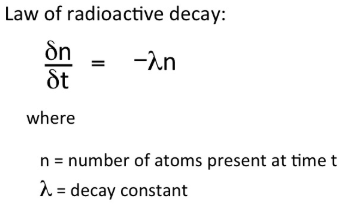The law about radioactive decay is a universal law, and it is used for describing the statistical behavior of a large number of nucleoids. The radioactive decay is not a regular process but a random one. It occurs at the level of single atoms, and according to the quantum theory, the prediction about the decay of a particular atom is not possible. In other words, it can be said that the nucleus of radionuclide is not having any memory. With time, the nucleus is not getting aged. So, with the time, the probability of its breaking is not increased. But despite its life span, it will stay constant. During this unpredicted decay, the unstable nucleus is randomly and spontaneously decomposed to make different nucleus. In this process, the radiation is given off in terms of high energy rays or atomic particles.

Calculations of Radioactive Decay
Relatively, the calculations of radioactive decay of nuclei are straightforward. It is owed to the fact that only one fundamental law is governing all kinds of decay processes. The law of radioactive decay states that probability per unit time, for decaying of the nucleus, remains constant, and it is not dependent on time. This constant is known as the decay constant and is denoted by the lambda. The probability of the constant greatly varies between different kinds of nuclei that lead to the observation of different decay rates.
Radioactive decay law: N = N.e-λt
Measurement of Radioactive Decay
Usually, the rate of radioactive decay is measured in terms of half-life. The half-life can be described as the amount of time, which is taken by the given isotope for losing half of its radioactivity. For the radioisotope, the half-life of 15 days means, that half of the atom will be decayed in these days. In the remaining 15 days, half of the leftover amount will be decayed and the process will go on. For the highly radioactive fission products, the half-life can be only, a millionth part of a second. But it may take billion years for the elements that are having a longer half-life.
For the shorter half-life, there are larger decay constants. The radioactive materials that are having a shorter half-life, are much more radioactive, but their radioactivity is rapidly lost. No matter that either the half-life is short or long, but after the passing of seven half-lives, the radioactivity is reduced to too much extent and as compare to initial activity it is less than 1%.
